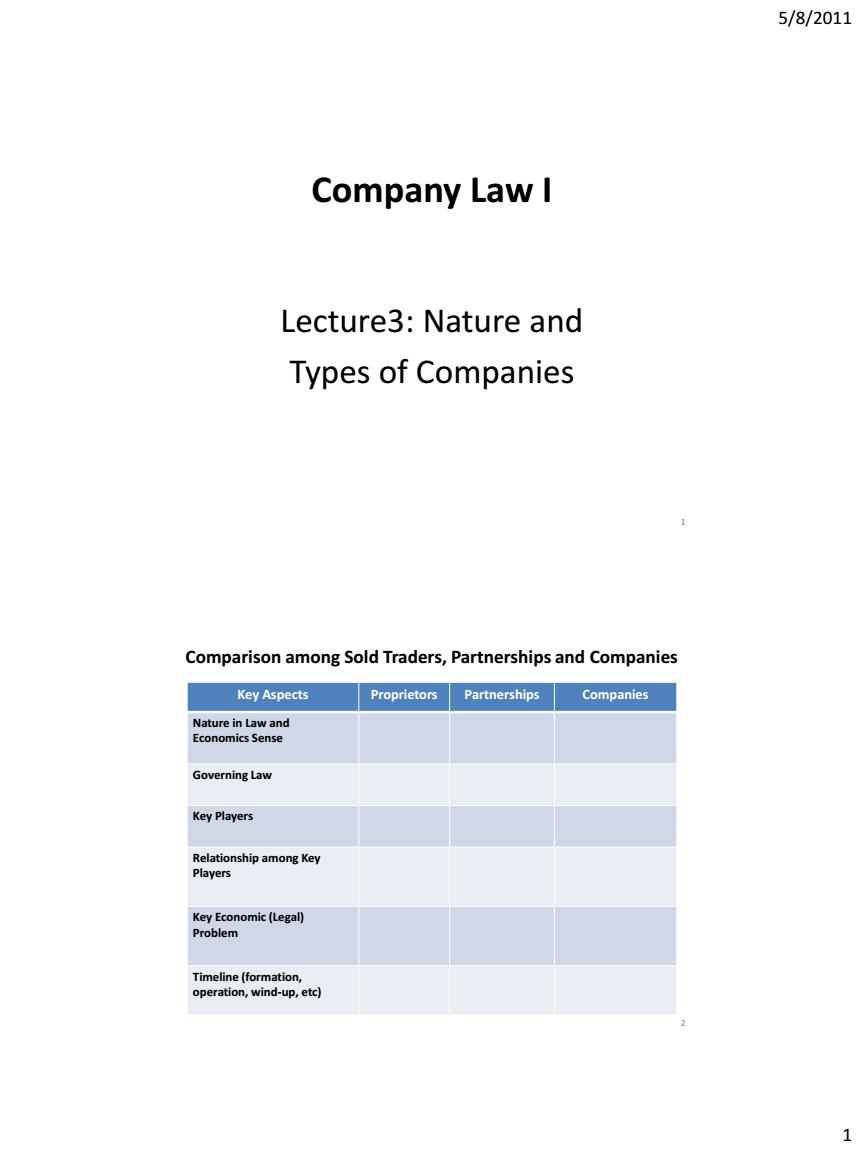
5/8/2011 Company Law I Lecture3:Nature and Types of Companies 1 Comparison among Sold Traders,Partnerships and Companies Key Aspects Proprietors Partnerships Companies Nature in Law and Economics Sense Governing Law Key Players Relationship among Key Players Key Economic (Legal) Problem Timeline(formation, operation,wind-up,etc) 2
5/8/2011 1 Company Law I Lecture3: Nature and Types of Companies 1 Comparison among Sold Traders, Partnerships and Companies Key Aspects Proprietors Partnerships Companies Nature in Law and Economics Sense Governing Law Key Players Relationship among Key Players Key Economic (Legal) Problem Timeline (formation, operation, wind-up, etc) 2
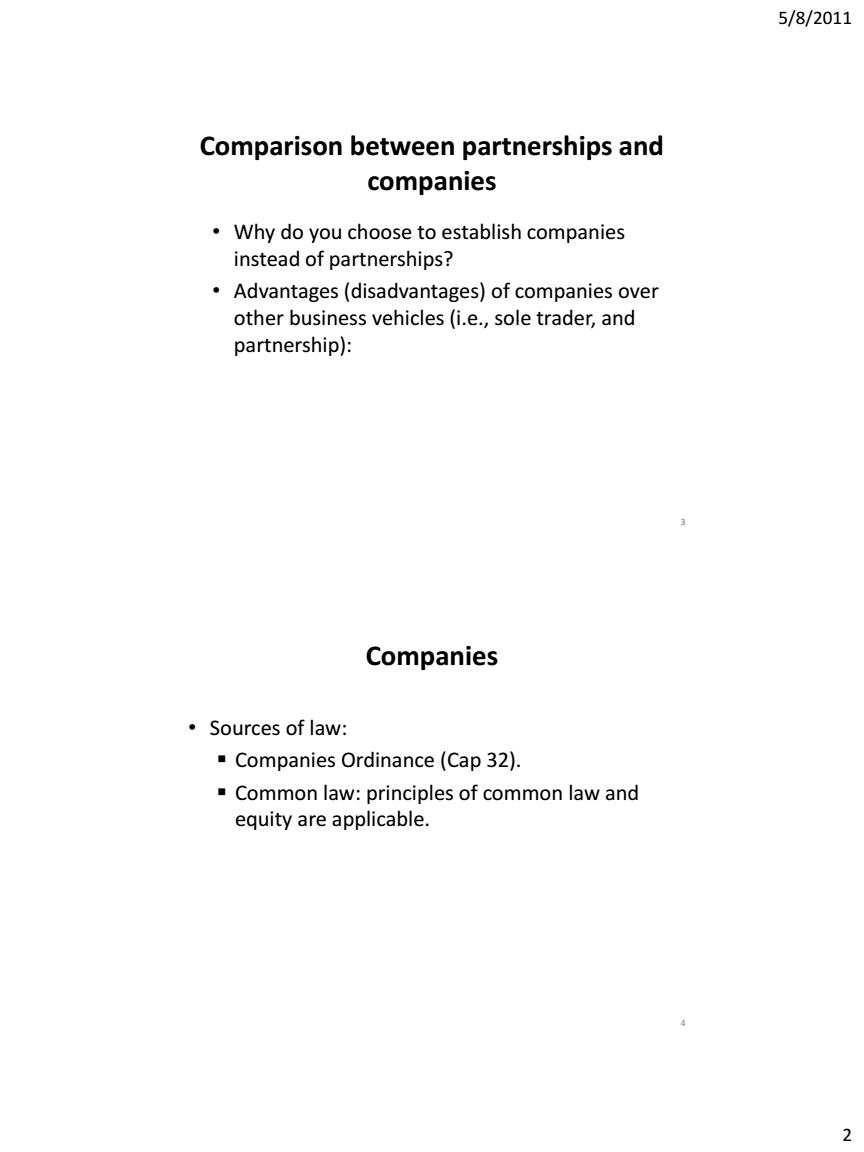
5/8/2011 Comparison between partnerships and companies Why do you choose to establish companies instead of partnerships? Advantages(disadvantages)of companies over other business vehicles (i.e.,sole trader,and partnership): 3 Companies ·Sources of law: Companies Ordinance(Cap 32). Common law:principles of common law and equity are applicable. 2
5/8/2011 2 Comparison between partnerships and companies • Why do you choose to establish companies instead of partnerships? • Advantages (disadvantages) of companies over other business vehicles (i.e., sole trader, and partnership): 3 Companies • Sources of law: Companies Ordinance (Cap 32). Common law: principles of common law and equity are applicable. 4
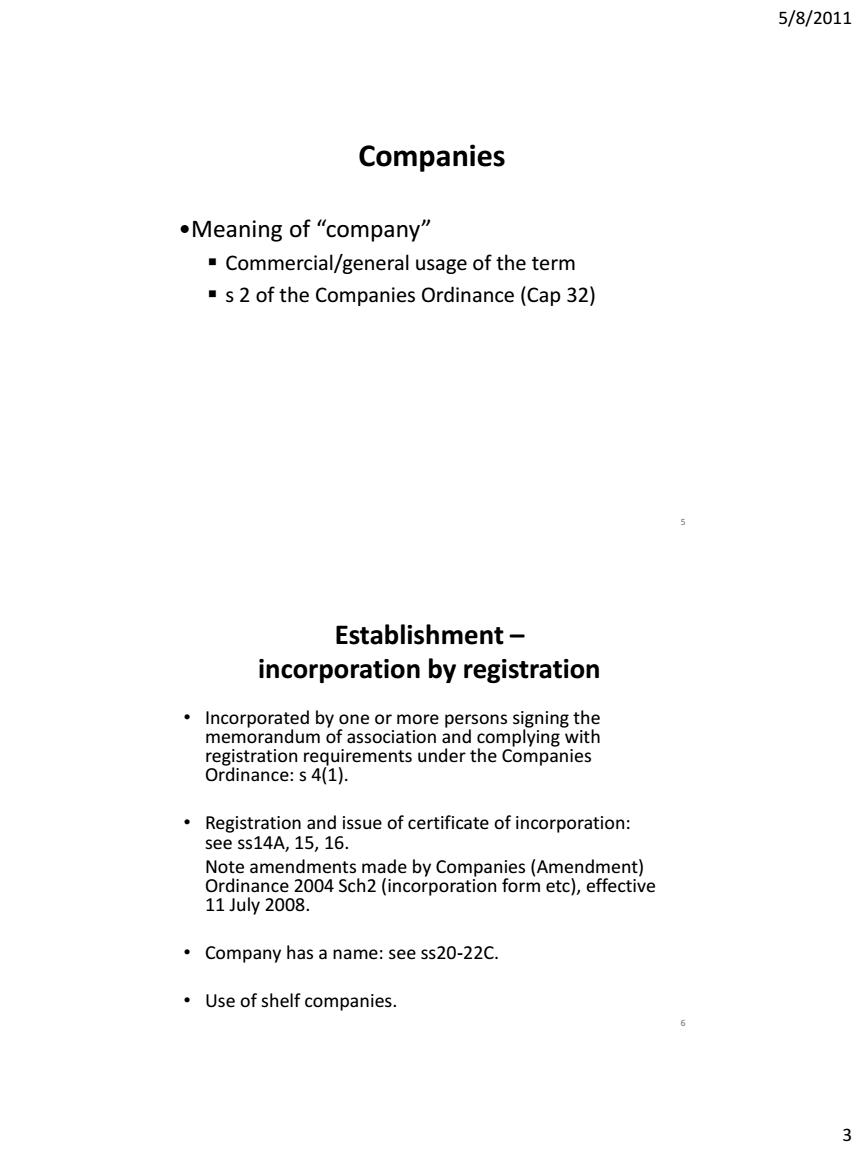
5/8/2011 Companies Meaning of“company'" Commercial/general usage of the term s 2 of the Companies Ordinance (Cap 32) 5 Establishment- incorporation by registration Incorporated by one or more persons signing the memorandum of association and complying with registration requirements under the Companies Ordinance:s 4(1). Registration and issue of certificate of incorporation: see ss14A,15,16. Note amendments made by Companies (Amendment) Ordinance 2004 Sch2 (incorporation form etc),effective 11July2008. Company has a name:see ss20-22C. Use of shelf companies. 6 3
5/8/2011 3 Companies •Meaning of “company” Commercial/general usage of the term s 2 of the Companies Ordinance (Cap 32) 5 Establishment – incorporation by registration • Incorporated by one or more persons signing the memorandum of association and complying with registration requirements under the Companies Ordinance: s 4(1). • Registration and issue of certificate of incorporation: see ss14A, 15, 16. Note amendments made by Companies (Amendment) Ordinance 2004 Sch2 (incorporation form etc), effective 11 July 2008. • Company has a name: see ss20-22C. • Use of shelf companies. 6
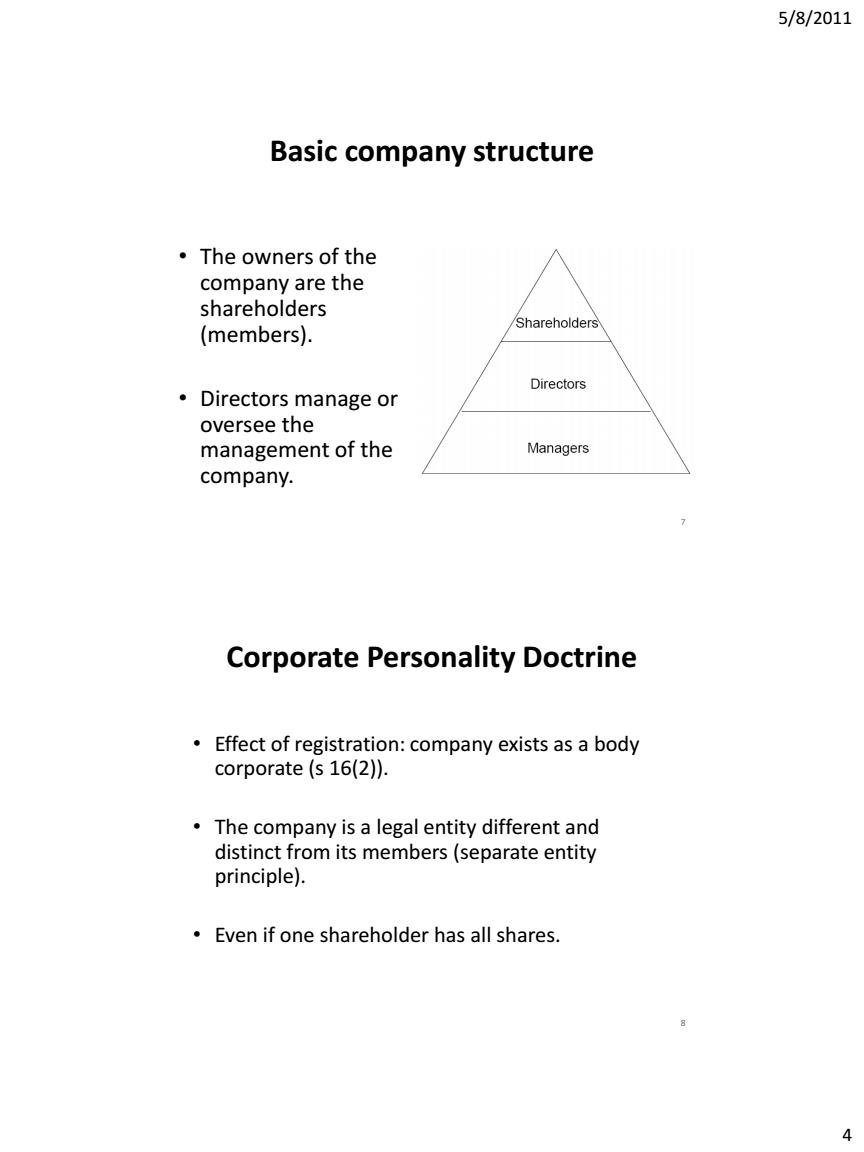
5/8/2011 Basic company structure ·The owners of the company are the shareholders Shareholders (members). Directors ·Directors manage or oversee the management of the Managers company. Corporate Personality Doctrine Effect of registration:company exists as a body corporate (s 16(2)). The company is a legal entity different and distinct from its members(separate entity principle). Even if one shareholder has all shares. 8 4
5/8/2011 4 Basic company structure • The owners of the company are the shareholders (members). • Directors manage or oversee the management of the company. 7 Corporate Personality Doctrine • Effect of registration: company exists as a body corporate (s 16(2)). • The company is a legal entity different and distinct from its members (separate entity principle). • Even if one shareholder has all shares. 8
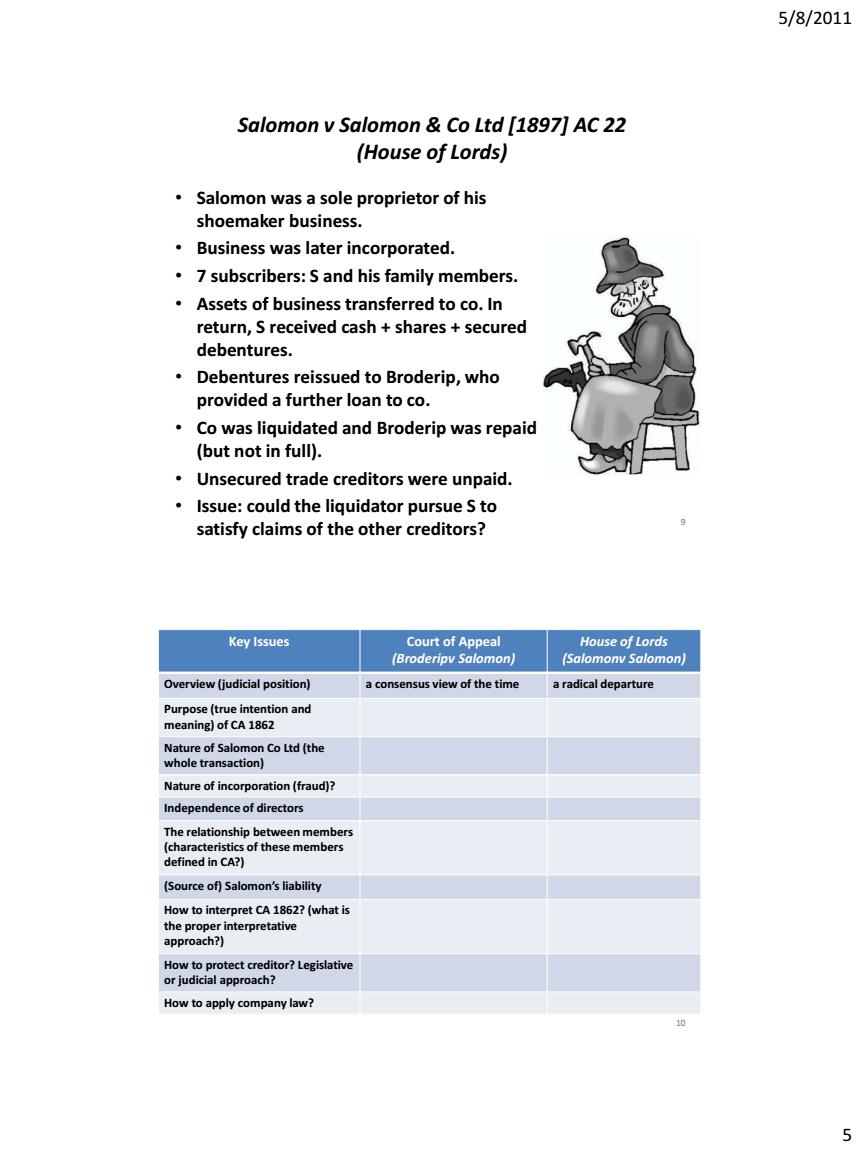
5/8/2011 Salomon v Salomon Co Ltd [1897]AC 22 (House of Lords) Salomon was a sole proprietor of his shoemaker business. Business was later incorporated. 7 subscribers:S and his family members. Assets of business transferred to co.In return,S received cash shares secured debentures. Debentures reissued to Broderip,who provided a further loan to co. Co was liquidated and Broderip was repaid (but not in full). Unsecured trade creditors were unpaid. Issue:could the liquidator pursue S to satisfy claims of the other creditors? Key Issues Court of Appeal House of Lords (Broderipv Salomon) (Salomonv Salomon) Overview (judicial position) a consensus view of the time a radical departure Purpose(true intention and meaning)of CA 1862 Nature of Salomon Co Ltd (the whole transaction) Nature of incorporation(fraud)? Independence of directors The relationship between members (characteristics of these members defined in CA?) (Source of)Salomon's liability How to interpret CA 1862?(what is the proper interpretative approach?) How to protect creditor?Legislative or judicial approach? How to apply company law? 10 5
5/8/2011 5 Salomon v Salomon & Co Ltd [1897] AC 22 (House of Lords) • Salomon was a sole proprietor of his shoemaker business. • Business was later incorporated. • 7 subscribers: S and his family members. • Assets of business transferred to co. In return, S received cash + shares + secured debentures. • Debentures reissued to Broderip, who provided a further loan to co. • Co was liquidated and Broderip was repaid (but not in full). • Unsecured trade creditors were unpaid. • Issue: could the liquidator pursue S to satisfy claims of the other creditors? 9 10 Key Issues Court of Appeal (Broderipv Salomon) House of Lords (Salomonv Salomon) Overview (judicial position) a consensus view of the time a radical departure Purpose (true intention and meaning) of CA 1862 Nature of Salomon Co Ltd (the whole transaction) Nature of incorporation (fraud)? Independence of directors The relationship between members (characteristics of these members defined in CA?) (Source of) Salomon’s liability How to interpret CA 1862? (what is the proper interpretative approach?) How to protect creditor? Legislative or judicial approach? How to apply company law?